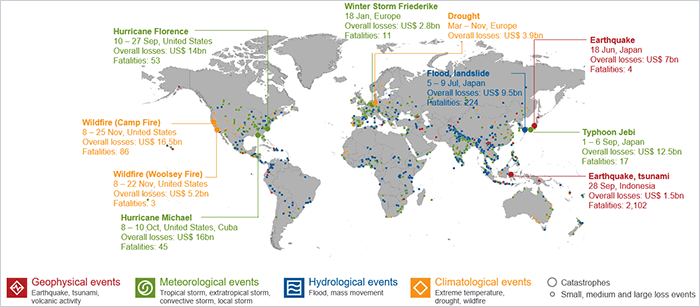Planning for Less Disruption in the Wake of Severe Weather and Disasters

Extreme weather events are becoming more widespread, but transportation and logistics pros can take steps to be better prepared and mitigate the impact.
Ask anyone in supply chain – the past few years have been particularly active for natural disasters and major weather events. Globally, natural disasters caused $160 billion in damage in 2018 according to a report by German insurance company Munich RE.
In the U.S. alone, the annual average number of billion-dollar disasters over the past three years has been more than double the long-term average, as reported by NOAA’s National Centers for Environmental Information.
If you work in transportation or logistics, you are undoubtedly aware of the supply chain challenges faced in the aftermath of such events.
This year has already seen its share of severe weather and disasters, and it doesn’t take a meteorologist to predict that these events will continue to happen. In any season, it’s wise to have a plan of action to mitigate risk in the wake of a storm.
Natural disasters send a ripple effect across supply chains as a whole — not just the affected areas.
When storms or disasters happen, there is often a large-scale government response to get needed help to affected areas, and this leads to them buying capacity within the trucking space to move food, water, and ice.
These critical efforts significantly disrupt typical freight flows in the United States, which was evident after Hurricane Harvey in Houston. After Harvey, capacity was pulled away from the Chicago market, 1,100 miles away from the impact area, and this led to a significant jump in rates and tightening in capacity.
What our team has learned from natural disasters is that the resulting tight capacity and increased rates can severely disrupt seasonal freight flows for months. It takes time for the trucking industry to reset the ordinary capacity levels and flows that existed before the weather event.

World Natural Catastrophes, 2018Source: © 2019 Munich Re, Geo Risks Research, NatCatSERVICE. As of March 2019.
While this change has an impact on rates, it can also influence other supply chain decisions where transportation rates play a major role. For example, determining where to produce goods, place new distribution centers, or service customers from long-term.
How shippers can prepare, minimize impact, and mitigate cost
While most transportation leaders would say the greatest challenge following extreme weather events is the impact to short-term rates and budgets, a perhaps greater risk not to overlook is physical assets.
The potential impact of natural disasters on production facilities and warehouses, for example, can be significant. Shippers are wise to assess this risk and determine if changes are needed to protect physical assets.
Having a backup plan is extremely important when dealing with a natural disaster. Shippers with physical assets in high-risk areas should build in flexibility as to how product is serviced to customers. Mitigation plans for the possibility of a facility going offline are also invaluable when faced with the situation.
For example, imagine you have a production facility in a hurricane-prone state like Florida and another in Georgia that makes the same product. Create a structure and plan to serve from the Georgia facility when Florida is impacted by weather. This may mean setting up routing plans with a few carriers to have ready. Even if there isn’t a great cost advantage, getting product to customers on time has value.
The value of technology and network in reducing supply chain friction
When a natural disaster happens, it’s important to quickly execute a plan of action. Here’s where being part of a strong ecosystem with proven technology lends speed and efficiency to help minimize impact. Among the benefits for TMS users and carriers in BluJay’s Global Trade Network for instance, are:
- A network that provides context to the disruption in freight flows, rate impact, and benchmarking for a shipper vs. BluDex market rates.
- The ability to tactically flag impacted shipments that may have incurred short-term incremental costs associated with dealing with a severe weather event, due to:
- Holding product waiting to be delivered.
- Increased detention charges.
- Product returns or reconsignments.
In addition, customers utilizing Logistics as a Service (LaaS) typically recover from severe weather more efficiently. Why? The LaaS team has dedicated resources tasked with staying up-to-date on local, regional, and national weather events.
When an event that could negatively impact a shipper is identified, LaaS teams will quickly assess at-risk shipments and make recommendations for adjusting shipping patters to beat or wait out significant weather. This can happen days in advance of a potential forecasted event.
Some examples include:
- Recommending overtime pay and extended shipping hours in order to load shipments ahead of storms.
- Identifying potentially impacted shipments and communicating with shippers’ customer service teams to assess if orders can wait until after a storm has passed.
- Keeping all stakeholders up to date with carrier operations and potential ETAs of shipments, especially when adjustments to current operations cannot be made.
With flooding, wildfires, storms and other severe weather happening more often of late, it’s essential for shippers to stay ahead and be prepared. Contact us to learn more about BluJay’s LaaS team and leveraging the full functionality of Transportation Management.
Related White Papers
Transforming Supply Chain Strategy to a Global Trade Network Model
The technology to support a global trade network is available today, it’s just a matter of looking at supply chain design in a new way, implementing it, and moving global trade to the forefront where your supply chain becomes today’s battleground. Download Now!
The Building Blocks of a Stronger, More Agile Supply Chain
This white paper details the benefits of having true end-to-end visibility, connectivity, and control for your supply chain, and by linking visibility to business processes and using this connectivity for decision-making and execution can have a significant impact on effectiveness and efficiency. Download Now!
More Resources from BluJay Solutions
Article Topics
BluJay Solutions News & Resources
5 Signs You May Need a More Modern Supply Chain Solution How Supply Chains are Becoming Resilient Amid Disruptions Supply Chain 2020 Innovation Update BluJay research focuses on the need to build resilient supply chains 5 Signs It’s Time to Modernize Your Supply Chain Technology Supply Chains of the Future Boost the Power of Your Trading-Partner Network More BluJay SolutionsLatest in Supply Chain
Walmart Unleashes Autonomous Lift Trucks at Four High-Tech DCs Ranking the Best Countries for Private Business in EMEA Frictionless Videocast: The Importance of Water at the U.S./Mexico Border with Commissioner Maria-Elena Giner, International Boundary and Water Commission Why are Diesel Prices Climbing Back Over $4 a Gallon? Plastic Pollution is a Problem Many Companies are Still Ignoring Luxury Car Brands in Limbo After Chinese Company Violates Labor Laws 80% of Companies Still Unsure How to Best Leverage AI, Study Finds More Supply Chain













